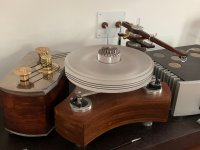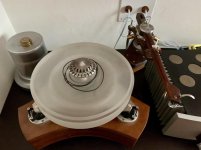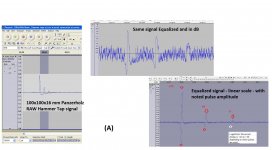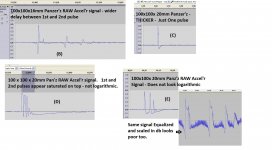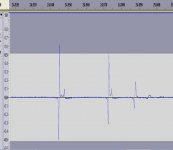Yes. Looks like that one was turned on a Lathe.
I think I saw somewhere that the guy really liked it. But he preferred another one made from a metal alloy (which I'm guessing rings much more than the P'holz). Seems like complete opposites eh?
So far, I'm liking the damped approach, but open to others.
I think I saw somewhere that the guy really liked it. But he preferred another one made from a metal alloy (which I'm guessing rings much more than the P'holz). Seems like complete opposites eh?
So far, I'm liking the damped approach, but open to others.
I believe you have it in a nutshell. I call it 'horses for courses', meaning people will like what they want to like, for whatever reasons. Therefore it would seem as though, subjectively, there are no universal panaceas. Objectively, one can measure the important parameters, and conclude which materials are the best, given the criteria. But whether the listener will like them, let alone prefer one material over another will be down to the individual.
The amount of, let's call it 'enhancements' (distortion, skewed FR, etc.) liked by listeners will also vary, and there is a preamplifier design on this forum which allows the listener to adjust the amount of harmonic distortion, to suit the listener. When materials vibrate, the resonance frequencies are similar to harmonic distortion, so 'enhancement' by vibrating panels (plinths, etc.) is something some people might like.
The amount of, let's call it 'enhancements' (distortion, skewed FR, etc.) liked by listeners will also vary, and there is a preamplifier design on this forum which allows the listener to adjust the amount of harmonic distortion, to suit the listener. When materials vibrate, the resonance frequencies are similar to harmonic distortion, so 'enhancement' by vibrating panels (plinths, etc.) is something some people might like.
Last edited:
Hifi have had a fashion trend since many years ago and perhaps the Panzerholz now is pretty fashion att he pint that seems all DIYer get crazy for it and is the ultimate solution for a plinth. However I think there is not an ultimate plinth solution and perhaps cheaper material shall work pretty well if not equal to the Panzerholz material.
DD or Idler TT MAY get some evident advantage from Panzeholz depending on the seriousness of the vibration
Adelmo
DD or Idler TT MAY get some evident advantage from Panzeholz depending on the seriousness of the vibration
Adelmo
Panzerholz is not fashion in the way other hifi might be considered. It is scientifically proven that it has a high damping factor. Other materials may have high damping factors, but so far, Panzerholz has been found to be the most desirable. However, not in its favour is the cost and rarity.
There may be other materials more suitable in most respects.
But I would agree that there have been 'materials of the month' for plinths. Such as ply, mdf and slate, none of which are any good for high damping plinths. But if one prefers lots of enhancement, distortion, smearing, they are some of the best...
There may be other materials more suitable in most respects.
But I would agree that there have been 'materials of the month' for plinths. Such as ply, mdf and slate, none of which are any good for high damping plinths. But if one prefers lots of enhancement, distortion, smearing, they are some of the best...
Last edited:
bgruhn-
Thanks for the feedback and the kind words. I've had a chance to listen to the table for about a week now and have some observations:
To start with, this table replaced a VPI Scout with 9 inch metal unipivot arm. I was never a fan of the unipivot, and the queuing mechanism never worked right (the arm dropped like a rock). I replaced the JMW9 arm with a 10" Jelco SA-750E (Thanks to Jam for sending me this great arm!), so besides the queuing working correctly, the distortion has also decreased. This is readily noticeable on complex passages and louder program material, especially with higher frequency components. There also seems to be less sibilance. I also replaced the motor with a 3 phase BLDC version with custom drive and 3 belts, so the only thing left from the VPI table (for now) is the platter and bearing, which I hope to replace with a DIY SS/Delrin version sometime in the future.
I've noticed some rather profound changes in the sound, all of them good. I'm not entirely sure which ones are attributable to the different tone arm and which are the result of the plinth design (or the two working together). The changes are not noticeable all the time, just under certain trying conditions. If a play an LP that I am very familiar with, everything will sound nearly the same until some heretofore subtle detail suddenly stands out as clearer, less muddled. It is like a layer of haze has been removed and it is most noticeable on complex passages where leading edge focus has improved dramatically.
I've also noticed a tightening and clarity in the mid and lower bass tracks. On Paul Simon's Graceland LP, especially the tracks "Diamonds on the soles of her shoes" and "You can call me Al", I can hear the bass player's fingers as he pulls the stings of his guitar. Fleetwood Mac never sounded so lush and enjoyable before, especially the bass and Christine McVie's voice on "Warm Ways".
One thing I have noticed and can attribute to the plinth, is something you mentioned: With the stylus lowered onto a stationary record and tapping the plinth or the shelf, the sound generated is a dull, low frequency thud that ends as quickly as it starts, where before, there was a definite Pingggg.... at around 600 Hz with a long sustain. The shelf thud isn't as reduced as I would have thought or hoped, but it is significantly less than tapping on the plinth directly. The former 600Hz resonance was sometimes audible, not as direct feedback, but almost a faint echo or ghost and sometimes a harshness on certain tracks that would excite it. It is complete absent now.
Hi,
Nice work!
I know it is an old post, but I am somehow new on this forum.....
Unipivot Tonearm are very sensitive to any vibration may come from the TT, bearing, or motor as well. If there are some of these issue in my opinion better not to use unipivot TA.
I do not have long experience as had only 4 TT of which one is a Lenco still in its original state. I sold the other 2, one Thorens and one Pioneer.
However the TT I am using most is a floating type as the Lenco need some tweaks. The floating system was achieved by Mag Lev and there is not any metal to metal contact. If I knock in the plinth while playing LP I cannot hear anything and the unipivot TA track well. The Mag Lev system take care of the knocking. Despite the magnets shift their center, my construction was able to use a platter with 4.3 Kg, a puc 0.5Kg plus other parts weigh and the mag keep well centered.
I also have a a Jelco 750 L 12 inch and honestly speaking using my Denon DL 103 it sounds better with the higher mass DIY unipivot wood tonearm. But according to my listening in case in the TT there are some serious frequency problem or vibration problem the Jelco perform better than my unipivot. I personally would not use a unipivot in a Rim or idler TT.
Motor pod it is separated from the plinth.
I have 2 motor pods:
One with single motor spinning at 360 RPM, therefore the motor pulley is around 30mm ( similar to the VPI I think ) Next test shall be to use Mylar tape belt or 3 rubber belts.
One with 2 motors spinning at 360 Rpm and a fly wheel, the platter in this case is driven by 3 belts. For this motor unit I am still ion the way to improve, but I can definitely hear the sound difference when the TT is not spinning att he correct RPM, for example 33.1 Rpm or 33.2 Rpm. May be is due to the 4.5 Kg fly wheel and the 3 belts. To test it I use a laser tachometer on while playing LP.
Material of the plinth: I think that having a floating mag lev, the motor pod separated from the plinth, the plinth s material in my modest opinion and in my case is less important. However I used 5 layers of Birtch ply, 3 hard ply and 2 softer ( in the middle ) I also used leads glued in the softer ply part.
Bearing have the shaft 13mm highly polished, 5 mm sphere and thrust plate, House of the bearing is made by one piece solid bronze with oil lubrication, tolerance pretty tight, when I change the oil the bearing takes long time to lower. The floor noise I consider very low ( by listening ) , I do not say is not there as I believe every bearing with thrust plate have some.
Platter is a 47 mm thick acrylic purchased from Scheuanalogue long time ago, outer diameter 320mm so better inertia compared to other platter that have smaller outer diam. What I like of this platter material is that either heavy LP ( 180Gr ) or lighter LP they both sound very good provided the tone arm hight is set well. The short coming is that with this platter material it is needed a puc, mine is 500 Gr.
For the tonearm decoupling from the aluminium plate I used Mahogany wood as I think this wood has good sonic characteristic and sound not too bad. Easy to work and to purchase. I treat it with some oil and wax.
Could I change something in this TT?. Perhaps the aluminium plate that have a sound proof treatment at the bottom where the bearing is fixed, but I do not have floor noise or vibration from the bearing so I am not planning to do anything to it. I forgot, I use thin bearing oil and I added Cera Tec 6%. I know is for cars, but I am testing it and since my bushes are not sintered type I think I can use the additive. My fly wheel using Cera Tec has increased the RPM 1% when bearing was cold ( I believe the Brinkmann concept to heat the bearing therefore keep a steady bearing s temperature and be able to use tighter tolerance ) Loosen bearing loose record informations....
Anyhow I see that lately most of the TT are not floating type and seems such type of TT are slowly disappearing. Pity I think.
Tks n rgds
Adelmo
one thing to bear in mind (remember). When one isolates a structure (such as a turntable) if there is any energy (vibrations) reaching the turntable, as it is isolated, it must deal with the vibrations itself. For example, a Linn LP12 type of construction uses springs to isolate the turntable from the plinth/support. But what is left is a platter/bearing connected to thin metal, to which a thin piece of mdf is connected. No wonder it has a 100 Hz hump! Same thing with a Lenco, unless measures are taken to damp the top plate, one is no further forward!
So if one isolates, one must take measures to damp that which has been isolated. After-market parts go a little way to solving the problem (i.e. thicker metal!)
So if one isolates, one must take measures to damp that which has been isolated. After-market parts go a little way to solving the problem (i.e. thicker metal!)
Last edited:
Hi,
The bearing fitted in a 10 and 20mm triangular aluminum, in the bottom of it sound proof treatment.
Tonearm support fitted with 3 brass bolts to the aluminium, made of 2 layer of solid wood decoupled by 4 tiny brass post.
Floor noise very low I hardly can hear.
Tks for the technical information, reds
Adelmo
The bearing fitted in a 10 and 20mm triangular aluminum, in the bottom of it sound proof treatment.
Tonearm support fitted with 3 brass bolts to the aluminium, made of 2 layer of solid wood decoupled by 4 tiny brass post.
Floor noise very low I hardly can hear.
Tks for the technical information, reds
Adelmo
Attachments
Test method or Lively Panzerholz?
Hi Cats Squirrel,
I think you're right. My test method is lacking. Here's another where I clamped the sample and gave it lots of little shots with the Jewelers Hammer.
It's a 100x100x16mm piece of Panzerholz. How do these pulses compare to the ones when you tested?
Thanks,
Hugh
decay rate, for a particular material, should be independent of size of test piece. Something which may make a difference is how the test piece is mounted, and what is at the boundaries (edges). Common boundary conditions include clamped (C), free (F) and simply support (SS), although others exist. For plinth duty, either C or SS are common. Each edge is considered, so that a panel (plate) may be only one of these, or a combination of two or all three. The results for C and SS will be very similar, FF will not.
Hi Cats Squirrel,
I think you're right. My test method is lacking. Here's another where I clamped the sample and gave it lots of little shots with the Jewelers Hammer.
It's a 100x100x16mm piece of Panzerholz. How do these pulses compare to the ones when you tested?
Thanks,
Hugh
Attachments
Also, do you agree with my choice of points for the Log Decrement? The Delta figure varies a lot depending on which ones I pick.
Hugh
Hugh
There is a point above which extra damping is not thought beneficial. This is said to be about 0.4 any more, and the benefits are slight (little reward on extra costs).
Do you recall where you've seen this this "0.4" recommendation? Was it in regard to Plinths, or just Audio Gear in general?
Hugh
Hi Cats Squirrel,
I think you're right. My test method is lacking. Here's another where I clamped the sample and gave it lots of little shots with the Jewelers Hammer.
It's a 100x100x16mm piece of Panzerholz. How do these pulses compare to the ones when you tested?
Thanks,
Hugh
remember, I'm trying to help 🙂...
your biggest problem is that you have clamped two edges. This will change the results. Stick a sturdy pin in one end, and suspend the test piece (do not hold the test piece!) Attach the accelerometer to the centre of the test piece with tape, and tap the other side to the accelerometer (also in the centre). Do this about 8 times, and discard the ones that do not look good (because the hammer hit the test piece at an angle, for example).
Look at the waveforms, and choose those which present an exponential decay of amplitudes if using a linear scale, or a straight line decay for dB scale. The latter is useful to check on exponential decay, but use linear scale for calculations.
HTH
Also, do you agree with my choice of points for the Log Decrement? The Delta figure varies a lot depending on which ones I pick.
Hugh
nope, see above! 😉
Do you recall where you've seen this this "0.4" recommendation? Was it in regard to Plinths, or just Audio Gear in general?
Hugh
Hi Hugh,
I don't recall exactly, but seem to remember it was an American paper published by the military. I'll have a look for it, but don't hold your breath.
I believe the point the author was making was that as the 'goodness' curve is exponential, one gets very little reward past a certain point. And that it is very easy to keep chasing numbers, rather than fully appreciate what those numbers represent. One has to reduce the amplitudes very quickly, but that is good enough, any more, and we waste time, money and effort. 🙂
remember, I'm trying to help 🙂...
your biggest problem is that you have clamped two edges. This will change the results. Stick a sturdy pin in one end, and suspend the test piece (do not hold the test piece!) Attach the accelerometer to the centre of the test piece with tape, and tap the other side to the accelerometer (also in the centre). Do this about 8 times, and discard the ones that do not look good (because the hammer hit the test piece at an angle, for example).
Look at the waveforms, and choose those which present an exponential decay of amplitudes if using a linear scale, or a straight line decay for dB scale. The latter is useful to check on exponential decay, but use linear scale for calculations.
HTH
Not a problem. I appreciate the help. Anything worth doing is worth doing.. twice (thrice?).
Stick a sturdy pin in one end, and suspend the test piece (do not hold the test piece!) Attach the accelerometer to the centre of the test piece with tape, and tap the other side to the accelerometer (also in the centre). Do this about 8 times, and discard the ones that do not look good (because the hammer hit the test piece at an angle, for example).
Look at the waveforms, and choose those which present an exponential decay of amplitudes if using a linear scale, or a straight line decay for dB scale. The latter is useful to check on exponential decay, but use linear scale for calculations.
HTH
Hi Cats Squirrel,
I have to confess that I'm puzzled by what I see in these shots.
(A) in the attached is what I thought might be a good one. When I Equalize and display in dB, each pulse seems to decay by a steady amount.
Is this what I need? Are we looking at acoustic echoes of the initial pulse? Or did I just capture the Hammer bouncing repeatedly on the surface?
In the second jpg (B through E), I added screen grabs of other pulses that seemed to have problems.
Hugh
Attachments
I reiterate, I am here to help you!😉
Those scans do not look good. I would expect something like this:
 damping ©wiki
damping ©wiki
I expect something like it, but maybe not quite so perfect.
Maybe we should check that all is working by looking at something which has little damping, like a thin metal sheet or low damping wood or plastic. Here is one of ebony (much loved by audiophiles as it 'has damping qualities'). Really? Here's one I prepared earlier.
 Ebony © cats squirrel
Ebony © cats squirrel
Note the exponential decay. Experiment with low damping materials until you are getting something like the ebony trace.
I'll say again, it is much easier to look at low damping factor materials than high ones!
Those scans do not look good. I would expect something like this:
 damping ©wiki
damping ©wikiI expect something like it, but maybe not quite so perfect.
Maybe we should check that all is working by looking at something which has little damping, like a thin metal sheet or low damping wood or plastic. Here is one of ebony (much loved by audiophiles as it 'has damping qualities'). Really? Here's one I prepared earlier.
 Ebony © cats squirrel
Ebony © cats squirrelNote the exponential decay. Experiment with low damping materials until you are getting something like the ebony trace.
I'll say again, it is much easier to look at low damping factor materials than high ones!
Last edited:
I don't think I've ever heard of anyone considering ebony to have "damping qualities," as it is traditionally and effectively used as a fretboard material in guitars, where one specifically does not want damping. It tests between 9.8 to 8.6 (10 -3).
It is often used for 'potting' cartridges and has been used in plinths. It has very little damping, I measured just a little more than the numbers you quote, but wood is notoriously variable and anisotropic! and varies according to moisture content.
Clearaudio Virtuoso V2 Ebony-body MM moving-magnet Phono Cartridge
| NineTribe - United Kingdom
Clearaudio Virtuoso V2 Ebony-body MM moving-magnet Phono Cartridge
| NineTribe - United Kingdom
Last edited:
- Home
- Source & Line
- Analogue Source
- DIY CLD Plinth Design--A measured Approach
